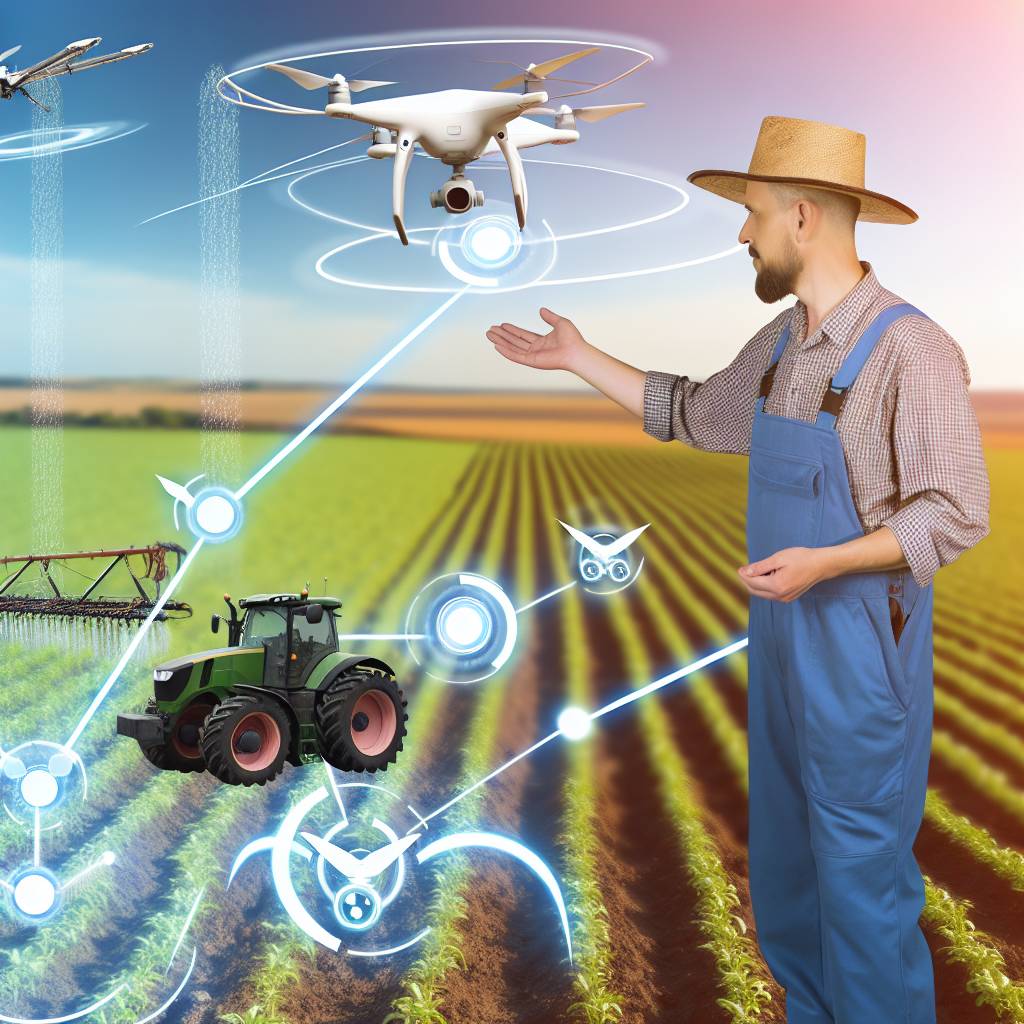Overview of Key Trade Agreements Impacting Agriculture
Introduction to Trade Agreements
Trade agreements play a critical role in shaping modern agriculture.
They dictate market access for agricultural products across borders.
Moreover, these agreements influence farming practices and sustainability efforts.
Significant Agreements in Agriculture
Several key trade agreements impact agricultural policies worldwide.
- The North American Free Trade Agreement (NAFTA) transformed trade between the U.S., Canada, and Mexico.
- The Comprehensive and Progressive Agreement for Trans-Pacific Partnership (CPTPP) includes diverse agricultural economies.
- The European Union’s Common Agricultural Policy (CAP) governs farming subsidies and trade within EU member states.
Effects on Farmers and Markets
Trade agreements affect farmers directly by altering market dynamics.
With increased exports, farmers can reach additional markets.
This can lead to higher profits and greater investment in innovation.
However, competition can also pressure local farmers to adapt their practices.
Environmental Considerations
Trade agreements can include clauses that focus on environmental standards.
For instance, the CPTPP emphasizes sustainable practices among member countries.
Additionally, agreements may encourage the adoption of eco-friendly technologies.
Challenges Faced by Farmers
While trade agreements offer opportunities, they also present challenges.
Farmers may struggle with compliance to international standards.
Furthermore, sudden market shifts can negatively impact their income.
Therefore, it is crucial for farmers to stay informed about trade developments.
Transform Your Agribusiness
Unlock your farm's potential with expert advice tailored to your needs. Get actionable steps that drive real results.
Get StartedThe Future of Agricultural Trade Agreements
The landscape of agricultural trade continues to evolve.
Emerging markets and global challenges will shape future agreements.
Moreover, digital trade provisions may redefine how agricultural goods are exchanged.
Farmers must remain flexible to adapt to these changes.
The Role of NAFTA/USMCA in North American Farming Practices
Impact on Trade Relations
NAFTA, now replaced by USMCA, reshaped trade among the US, Canada, and Mexico.
This agreement facilitated the movement of agricultural goods across borders.
Farmers benefited from reduced tariffs on exports and imports.
This access increased market opportunities for many agricultural producers.
Consequently, producers adapted their practices to meet international standards.
Changes in Crop Production
With USMCA, crop production in North America became more integrated.
Crops like corn and soybeans were central to this transformation.
This integration encouraged specialization and increased efficiency.
As a result, farmers shifted focus to crops with higher market demand.
Many producers now utilize advanced technologies to optimize yields.
Influence on Livestock Farming
USMCA significantly impacted the livestock sector as well.
It boosted exports of beef, poultry, and pork from the US and Canada.
This demand necessitated changes in livestock breeding and management practices.
Farmers adopted more sophisticated health and nutrition protocols.
As a result, the quality of livestock products improved considerably.
Sustainability Considerations
NAFTA and USMCA have spurred a focus on sustainable farming practices.
Both agreements promote the use of environmentally friendly farming methods.
Farmers are encouraged to implement conservation practices and reduce waste.
This shift not only benefits the environment but also enhances marketability.
Consequently, sustainable practices are becoming integral to modern farming.
Showcase Your Farming Business
Publish your professional farming services profile on our blog for a one-time fee of $200 and reach a dedicated audience of farmers and agribusiness owners.
Publish Your ProfileThe Future of Farming Under Trade Agreements
The evolution of trade agreements continues to influence farming practices.
Farmers must stay informed about changing trade policies and regulations.
Future agreements will likely prioritize sustainability and innovation.
As markets fluctuate, adaptability will be crucial for success.
Understanding these dynamics is essential for farmers today.
EU Common Agricultural Policy and its Effects on Member States
Overview of the EU Common Agricultural Policy
The EU Common Agricultural Policy (CAP) plays a crucial role in European agriculture.
It provides financial support to farmers across member states.
Additionally, CAP aims to ensure food security in the EU.
Farmers benefit from direct payments and rural development programs.
These payments help stabilize farm income during market fluctuations.
Impacts on Farming Practices
The CAP influences various farming practices across Europe.
For instance, it encourages sustainable farming approaches.
Moreover, it promotes environmentally friendly agricultural techniques.
Farmers adopt practices that improve soil health and reduce pollution.
Regional Variations in Implementation
Each member state tailors the CAP to its local needs.
For example, France focuses on dairy and crop production support.
Conversely, Spain emphasizes olive oil and fruit production.
Such variations lead to different agricultural practices across Europe.
Challenges and Criticisms
Despite its benefits, the CAP faces criticism from various sectors.
Some argue that it disproportionately benefits larger farms.
Additionally, there are concerns about environmental sustainability.
Changes in legislation attempt to address these issues.
However, the balance between productivity and sustainability remains delicate.
Future of the CAP
The CAP is evolving to meet current global challenges.
Future reforms aim to enhance ecological and social objectives.
These reforms will likely focus on climate change adaptation.
Furthermore, they will promote rural development and innovation.
As a result, CAP continues to shape modern farming practices across Europe.
Explore Further: Understanding Pesticide Registration Processes
The Impact of the Trans-Pacific Partnership (TPP) on Global Agriculture
Overview of the TPP
The Trans-Pacific Partnership, or TPP, is a trade agreement involving multiple nations.
It aimed to enhance economic growth and deepen ties among member countries.
The TPP covers various sectors, including agriculture, manufacturing, and services.
By reducing tariffs, it seeks to promote international trade and investment.
Influence on Agricultural Exports
TPP significantly impacts agricultural exports from member nations.
For instance, countries like Vietnam benefit from access to new markets.
Moreover, the agreement facilitates the export of rice, seafood, and textiles.
In contrast, other members face increased competition in their agricultural sectors.
Regulatory Standards and Practices
The TPP establishes common standards for food safety and quality.
This harmonization simplifies trade between countries.
Additionally, it encourages innovative farming practices among member states.
Showcase Your Farming Business
Publish your professional farming services profile on our blog for a one-time fee of $200 and reach a dedicated audience of farmers and agribusiness owners.
Publish Your ProfileSuch practices include sustainable farming and technological advancements.
Economic Growth and Job Creation
By opening new markets, the TPP spurs economic growth in agriculture.
This growth leads to job creation in both the farming and export sectors.
Furthermore, increased agricultural productivity enhances food security.
Ultimately, this growth impacts rural communities positively.
Controversies and Challenges
Despite its benefits, the TPP faces criticism from various stakeholders.
Some argue it favors large agribusinesses over small farmers.
Additionally, concerns arise over environmental impacts and labor rights.
These issues highlight the need for balanced trade policies.
Looking to the Future
The future of global agriculture depends on agreements like the TPP.
As nations navigate trade complexities, farmers must adapt accordingly.
Innovations in agricultural practices will be essential for success.
The TPP shapes modern farming practices through regulations and market access.
Discover More: Understanding the Connection Between Rural Policies and Farming
Bilateral Trade Agreements and Their Influence on Commodity Prices
Understanding Bilateral Trade Agreements
Bilateral trade agreements involve two countries.
They aim to enhance trade between the partners.
These agreements reduce tariffs and import quotas.
Consequently, they can lower prices for consumers.
Farmers benefit from these agreements as well.
They gain access to larger markets for their products.
This access can lead to increased competition and better prices.
The Impact on Commodity Prices
Commodity prices react significantly to trade policies.
When trade barriers drop, prices often decrease.
Lower prices benefit consumers but may hurt producers.
Conversely, high tariffs can inflate prices.
Producers might gain higher revenues initially, but consumers face higher costs.
This dynamic can affect overall market stability.
Case Studies of Key Agreements
The North American Free Trade Agreement (NAFTA) offers valuable insights.
It created a trilateral trading block among the U.S., Canada, and Mexico.
Farmers in these countries saw shifts in production and prices.
Similarly, the Trans-Pacific Partnership (TPP) aimed to enhance agricultural trade across the Pacific Rim.
Although the U.S. withdrew, the remaining countries moved forward with new trade policies.
Effects on Agricultural Sectors
Diverse agricultural sectors experience different impacts.
For instance, the corn market saw increased exports due to trade agreements.
In addition, soybean farmers benefitted from improved market access.
Conversely, dairy farmers faced challenges in expanding their markets.
Increased competition from foreign producers altered domestic pricing strategies.
Thus, the effects vary across agricultural goods.
Future Implications for Farming Practices
As trade agreements evolve, farmers must adapt.
They need to stay informed about changing policies.
Showcase Your Farming Business
Publish your professional farming services profile on our blog for a one-time fee of $200 and reach a dedicated audience of farmers and agribusiness owners.
Publish Your ProfileAdjusting marketing strategies becomes crucial for survival.
Additionally, carbon pricing within trade deals may influence how farms operate.
Sustainable practices could become more important in securing favorable trade terms.
Ultimately, understanding these agreements allows farmers to navigate complex market landscapes.
It empowers them to make informed decisions for future prosperity.
Discover More: How Import Export Policies Affect Crop Prices And Farming

Regional Trade Agreements in Africa and Their Role in Food Security
Introduction to Trade Agreements
Trade agreements create a framework for the exchange of goods and services.
In Africa, these agreements significantly influence agriculture and food security.
They help shape local farming practices and regional market dynamics.
Key Trade Agreements in Africa
Several regional trade agreements impact food security in Africa.
The African Continental Free Trade Area (AfCFTA) aims to reduce intra-continental tariffs.
This agreement facilitates easier access to markets for farmers across the continent.
Another critical agreement is the Economic Community of West African States (ECOWAS) Trade Liberalization Scheme.
It emphasizes free movement of agricultural products among member states.
Such agreements collectively enhance food availability and security.
Impact on Agricultural Practices
Trade agreements influence agricultural investment and practices.
Farmers adapt their production methods to meet regional market demands.
For example, the demand for organic produce is on the rise.
In response, many farmers are shifting towards sustainable farming techniques.
These adaptations help improve resilience against climate change.
Food Security Benefits
Regional trade agreements play a vital role in improving food security.
They enhance collaboration among nations in addressing food shortages.
Trade agreements also encourage innovations in food production and distribution.
By reducing trade barriers, they improve affordability of food products.
Moreover, these agreements promote local sourcing and consumer trust in domestic produce.
Challenges and Considerations
Despite the benefits, trade agreements face significant challenges.
For instance, inconsistency in regulatory standards can hinder farmers.
Additionally, smallholder farmers may struggle to compete with larger entities.
It is essential to address these challenges to maximize the benefits of trade agreements.
Equitable resource distribution and support for small farmers will enhance food security.
Learn More: Training Farm Workers On Chemical Safety
How Trade Agreements Shape Sustainable Farming Practices
Defining Sustainable Farming
Sustainable farming focuses on meeting current food needs efficiently.
It emphasizes environmental health through eco-friendly practices.
Furthermore, it aims to protect natural resources for future generations.
The Role of Trade Agreements
Trade agreements significantly influence modern farming methods.
They set regulations that can encourage or discourage sustainable practices.
For instance, agreements often promote the use of innovative technologies.
Additionally, they can facilitate the sharing of best practices globally.
Notably, agreements can enhance market access for sustainable products.
Examples of Key Trade Agreements
The North American Free Trade Agreement has impacted farming sectors in North America.
Showcase Your Farming Business
Publish your professional farming services profile on our blog for a one-time fee of $200 and reach a dedicated audience of farmers and agribusiness owners.
Publish Your ProfileIt has altered trade dynamics and production patterns among the member countries.
Similarly, the Comprehensive and Progressive Agreement for Trans-Pacific Partnership promotes regional agricultural sustainability.
Benefits of Sustainable Practices in Trade Agreements
Sustainable farming reduces the carbon footprint of agricultural practices.
Moreover, it ensures healthier food systems that benefit consumers.
Trade agreements often incentivize farmers to adopt sustainable methodologies.
Challenges Faced
Despite the benefits, challenges persist in integrating sustainability into trade agreements.
Some stakeholders resist changes due to perceived risks or costs.
Additionally, developing countries may lack resources to comply with stringent standards.
Looking Forward
Future trade agreements should prioritize sustainability more comprehensively.
It is essential to create mechanisms that support farmers in transitioning.
Ultimately, aligning trade policies with sustainable practices can yield transformative impacts.
Future Trends: Emerging Trade Agreements and Their Potential Impact on Modern Farming
Trade Agreements Shaping Agriculture
Emerging trade agreements significantly influence modern farming practices.
These agreements often enhance market access for farmers and producers.
Additionally, they create opportunities for collaboration among nations.
As a result, farmers can explore new markets abroad.
Technological Innovations and Collaborations
Trade agreements facilitate the exchange of agricultural technologies.
For instance, countries can share precision farming techniques.
This collaboration enhances productivity and sustainability in farming.
Moreover, access to advanced tools becomes more widespread.
Regulatory Standards and Compliance
Emerging trade deals often establish common regulatory standards.
These standards can streamline processes for farmers.
Furthermore, they provide a clear framework for compliance.
Consequently, farmers reduce the risk of facing trade barriers.
Environmental Considerations
Some trade agreements incorporate environmental protections.
These provisions encourage sustainable agricultural practices.
They also promote the use of eco-friendly farming techniques.
In turn, this can lead to improved outcomes for ecosystems.
Impact on Smallholders
Trade agreements can have varied effects on smallholder farmers.
For instance, they may gain access to larger markets.
However, increased competition can also pose challenges.
To thrive, small farmers must adapt their strategies accordingly.
Future Prospects and Adaptations
The landscape of agriculture will continue evolving with new agreements.
Farmers will likely embrace innovative practices to stay competitive.
Moreover, adapting to changes in global demand becomes crucial.
In this way, trade agreements play a vital role in modern farming’s future.




